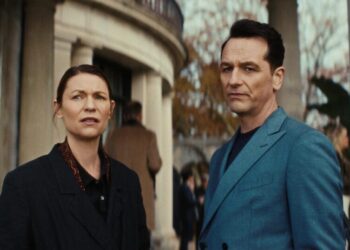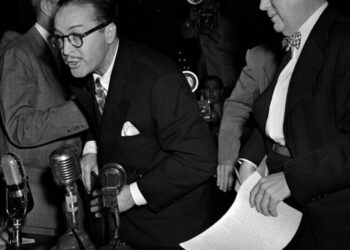At an art fair, in spite of (or more likely because of) the glut of work on offer, it can be difficult to really see. You wander the aisles, ducking in and out of gallery booth after gallery booth, waiting for something to grab your attention.
At Paris Photo, the international photography fair held each fall at the city’s Grand Palais, which opened Thursday and runs through Sunday, the conditions are favorable, with light streaming through the building’s high, vaulted glass ceiling. But they are no less overwhelming.
The first edition of Paris Photo, in 1997, had 53 exhibitors. This year there are 222: 179 galleries and 43 publishers from 33 countries, including 60 participants taking part for the first time.
I arrived anticipating novelty and carrying weighty questions: What is the state of photography today? What are the preoccupations, formal and conceptual, of young photographers across the world? Who, regardless of age, is using the medium in new and surprising ways?
Modest works can be just as seductive as flashy ones, but — without investing too much in the idea of an artwork’s aura — it can be hard to say immediately what pulls you in to look more closely, to spend a quiet moment amid the melee and consider one image in a sea of so many.
Is it the composition? The colors? The contrast of light and shadow? The subject matter? A familiarity you can’t quite pinpoint? Or is this an image you have already seen in some variety, an artist you’re familiar with, a reinforcement of the power of an individual style and oeuvre?
This year’s Paris Photo opens with opens with a bang. At the entrance, the viewer is greeted by a 130-foot installation of work by Sophie Ristelhueber, this year’s winner of the prestigious Hasselblad Award. The French photographer is known for her images of war’s impact on bodies and landscapes, and this striking display of photographs in various sizes charts the ravages of human conflict in Lebanon, Syria, the West Bank, Bosnia, Armenia and beyond.
Ristelhueber’s singular work got me off to a hopeful start, but I’m sorry to report that — after hours of diligently visiting every booth in the sprawling space — I left with no answers, though perhaps the better for it: My questions were, to an extent, conditioned by the desires of the market and a cultural appetite for relentless evolution: more, new, better. But art doesn’t really work that way.
In reality, the most surprising and impressive photographers on display were those whose work was made many decades ago but is now being seen anew or, in some cases, for the first time.
Here are five photographers I discovered whose oeuvres somehow hold a longevity of looking — an ineffable quality that can feel increasingly rare.
Yildiz Moran
Born in 1933, Yildiz Moran was Turkey’s first academically trained female photographer, according to Galeri Nev, which is showing her work in Paris — but initially she wanted to be a painter. At the suggestion of her uncle, a leading art historian, she went abroad to study photography instead, training at Bloomsbury Technical College in London from 1950-52.
Although she staged successful exhibitions in Britain, Moran was not content to stay in one place and rest on her laurels. Toting her Rolleiflex, she traveled across postwar Europe, photographing the changed landscapes of Spain and Portugal before returning to Turkey, where she captured its people and geography in black-and-white.
In some images, we are taken through the smooth hills, rocky valleys and ancient ruins of Anatolia, the Asian peninsula that makes up most of Turkey. In others, we are with people: a man juggling, a group of workers, a girl whose face is turned toward the sun with quiet reverence.
Elegant and spare, with evocative, poetic compositions, Moran’s photographs recall aspects of the French photographer Henri Cartier-Bresson, as well as Dorothea Lange, the great documenter of Depression-era America. From 1970 until her death in 1995, Moran abandoned photography to have a family and translate the works of her poet husband. Thousands of negatives remain unprinted, but her estate is working to restore this amazing oeuvre.
Fred Herzog
Fred Herzog also left a large cache of unprinted negatives when he died — though his work is at the other end of the aesthetic spectrum from Moran’s.
The photographer was born in Stuttgart in 1930 and settled in Vancouver after emigrating to Canada in 1952. Working as a medical photographer by day (side hustles are common among photographic artists), on evenings and weekends Herzog walked the streets of Vancouver, a city known for its majestic natural surroundings.
Rather than turn his eye to the city’s mountains, dense forests and shining waters, he preferred its working-class neighborhoods, its window displays and industrial life, the human drama and bustle of daily life — and the shock of color that so often makes for a lasting image: a curving phalanx of bright orange taxis on a misty morning; a bright pink umbrella; the red-and-black lumberjack shirt of a worker painting a ship.
These works are beautifully composed but artless, their colors moving the eye around the image like a carefully considered painting waiting in the wilds of the everyday. Herzog remained relatively unknown until 2006, when technology allowed him to print his Kodachrome slides with the chromatic intensity he desired. When he died in 2019, he left behind 100,000 unseen slides.
Marisa González
The multimedia artist Marisa González was born in Spain in 1943, and traveled to the United States in the early 1970s to study first at the Art Institute of Chicago, then at the Corcoran School of Art and Design in Washington.
One of her teachers here was the great feminist artist Mary Beth Edelson, who offered herself as a model for a work that the young photographer was making in response to the violence against women under the Pinochet regime in Chile.
At the fair, González showed me the newspaper clippings on that subject that inspired her 1975 work “The Discharge: Violence Against Women Project,” for which she asked teachers and fellow students to embrace the feelings that the articles stirred. She photographed their anguished faces up close and printed them on pages of colored acetate — blue, rust brown — then arrayed them in grids.
In one, Edelson’s mouth is wide open, her head thrown back. In another, the sorrowful faces of two women are pressed close together, almost overlapping. (A printing trick, or a remarkable intimacy?) These works seem as urgent as ever, not only for their subject matter, but also because they remind us that photography can be collaborative, and the result of vital social networks.
Catherine DeLattre
In the unbelievably bright, square-format photographs of the American photographer Catherine DeLattre, the elder ladies of the Upper West Side are legion.
One pushes a metal shopping cart with purpose, her navy beret tilted, her lips perfectly painted in fuchsia. Another, dressed to the nines in floral getup with an elegant brooch and a strand of pearls, fixes us in her gaze through thick glasses. Yet another looks at us, looking at her, garbed in a mustard leather coat, her hair curlers still in, but carefully covered with a white head scarf. Women are, after all, the greatest of multitaskers: things to do, places to go, people to see.
For a year, DeLattre visited two street corners in New York City every day, capturing the passers-by with quiet but chic dignity. They are often caught in full sun, colorful clothes popping against the pavement, perhaps echoing other similar shades nearby. The frame of each image is busy and full.
For many years the artist, who was born near Pittsburgh, taught in art schools and worked in film and television while also pursuing her own remarkable work that should be considered a kind of 1980s descendant of the great colorist and street life documenter Helen Levitt.
All-Japan Students Photo Association
Does a collective experience require a collective vision? From 1968 to 1971, a group of young photographers, the All-Japan Students Photo Association, produced a project called “Hiroshima Day.” The budding artists hailed from high school and university photography clubs across Japan, coming together under the guidance of the photography critic Tatsuo Fukushima.
Their project title refers to Aug. 6, the date of the annual Hiroshima Peace Memorial Ceremony, which remembers the atomic bomb that killed about 140,000 people and destroyed a third of the city. Although that might suggest that the group’s photographs would look to past traumas, they are instead a compelling record of history’s ramifications on the contemporary geography of the city, which, by the early 1970s, was about to undergo sweeping state-planned reconstruction.
Across atmospheric, unattributed black-and-white images, streets and homes are as scarred as bodies: The gnarled hands of a bombing survivor hold a sleeping cat; slums built on ruins house precarious citizens who will soon be displaced by urban development amid rapid social change in Japanese society.
One photograph shows the peace ceremony itself — a mass of people, dressed in white — but “Hiroshima Day” as a project was not confined to any date. Instead, the students used it to ask what Hiroshima meant and might continue to mean. It’s a question that still remains.
The post Discovering 5 Treasures of Photography appeared first on New York Times.




